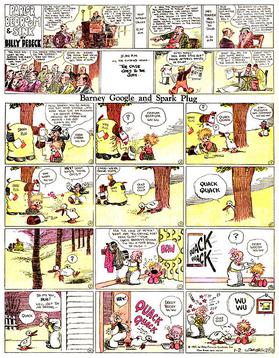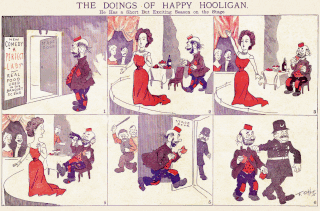
A. Piker Clerk was a short-lived yet influential newspaper American comic strip created in 1903 by the cartoonist Clare Briggs. It was syndicated in William Randolph Hearst's Chicago American until June 7, 1904. [1]

A. Piker Clerk was a short-lived yet influential newspaper American comic strip created in 1903 by the cartoonist Clare Briggs. It was syndicated in William Randolph Hearst's Chicago American until June 7, 1904. [1]
A horseracing-related comic strip seen daily on the sports pages, A. Piker Clerk gave readers a racehorse tip each day. The strip featured the exceedingly thin Mr. Clerk, a character with a gambling problem, who placed daily bets on a horse in the Chicago races each day. The following day Clerk's win or loss was posted, as described in Toonopedia by comics historian Don Markstein:
It soon inspired similar strips in other papers, notably A. Mutt, which began in 1907 in the San Francisco Chronicle and evolved into Mutt and Jeff . In Encyclopædia Britannica Blog, Robert McHenry wrote:
Although the strip brought national fame to Briggs, it was cancelled in June 1904 because Hearst considered it to be vulgar, [2] [4] although some consider this an urban myth. [5]

Mutt and Jeff is a long-running and widely popular American newspaper comic strip created by cartoonist Bud Fisher in 1907 about "two mismatched tinhorns". It is commonly regarded as the first daily comic strip. The concept of a newspaper strip featuring recurring characters in multiple panels on a six-day-a-week schedule had previously been pioneered through the short-lived A. Piker Clerk by Clare Briggs, but it was Mutt and Jeff as the first successful daily comic strip that staked out the direction of the future trend.

All-American Comics is a comics anthology and the flagship title of comic book publisher All-American Publications, one of the forerunners of DC Comics. It ran for 102 issues from 1939 to 1948. Characters created for the title, including Green Lantern, the Atom, the Red Tornado, Doctor Mid-Nite, and Sargon the Sorcerer, later became mainstays of the DC Comics line.

King Features Syndicate, Inc. is an American content distribution and animation studio, consumer product licensing and print syndication company owned by Hearst Communications that distributes about 150 comic strips, newspaper columns, editorial cartoons, puzzles, and games to nearly 5,000 newspapers worldwide. King Features Syndicate also produces intellectual properties, develops new content and franchises, like The Cuphead Show!, which it produced with Netflix, and licenses its classic characters and properties.

Barney Google and Snuffy Smith, originally Take Barney Google, for Instance, is an American comic strip created by cartoonist Billy DeBeck. Since its debut on June 17, 1919, the strip has gained a large international readership, appearing in 900 newspapers in 21 countries. The initial appeal of the strip led to its adaptation to film, animation, popular song, and television. It added several terms and phrases to the English language and inspired the 1923 hit tune "Barney Google " with lyrics by Billy Rose, as well as the 1923 record "Come On, Spark Plug!"

William Morgan DeBeck, better known as Billy DeBeck, was an American cartoonist. He is most famous as the creator of the comic strip Barney Google, later retitled Barney Google and Snuffy Smith. The strip was especially popular in the 1920s and 1930s, and featured a number of well-known characters, including the title character, Bunky, Snuffy Smith, and Spark Plug the race horse. Spark Plug was a merchandising phenomenon, and has been called the Snoopy of the 1920s.

Frank Oscar King was an American cartoonist best known for his comic strip Gasoline Alley. In addition to innovations with color and page design, King introduced real-time continuity in comic strips by showing his characters aging over generations.
A daily strip is a newspaper comic strip format, appearing on weekdays, Monday through Saturday, as contrasted with a Sunday strip, which typically only appears on Sundays. They typically are smaller, 3–4 grids compared to the full page Sunday strip and are black and white.

The Sunday comics or Sunday strip is the comic strip section carried in most Western newspapers. Compared to weekday comics, Sunday comics tend to be full pages and are in color. Many newspaper readers called this section the Sunday funnies, the funny papers or simply the funnies.

Harry Conway "Bud" Fisher was an American cartoonist who created Mutt and Jeff, the first successful daily comic strip in the United States.

Clare A. Briggs was an early American comic strip artist who rose to fame in 1904 with his strip A. Piker Clerk. Briggs was best known for his later comic strips When a Feller Needs a Friend, Ain't It a Grand and Glorious Feeling?, The Days of Real Sport, and Mr. and Mrs.

August Daniel Carter (1895–1957) was an American comic strip cartoonist who created the long-running Just Kids strip. He was known as Ad Carter, the signature he used on his strips.

Little Jimmy, originally titled Jimmy, is a newspaper comic strip created by Jimmy Swinnerton. With a publication history from February 14, 1904, to April 27, 1958, it was one of the first continuing features and one of the longest running.

Happy Hooligan is an American comic strip, the first major strip by the already celebrated cartoonist Frederick Burr Opper. It debuted with a Sunday strip on March 11, 1900 in the William Randolph Hearst newspapers, and was one of the first popular comics with King Features Syndicate. The strip ran for three decades, ending on August 14, 1932.
This is a timeline of significant events in comics in the 1910s.
This is a timeline of significant events in comics in the 1900s.
Baron Bean is a newspaper comic strip created by the cartoonist George Herriman. Baron Bean was distributed by King Features Syndicate.
A comic strip syndicate functions as an agent for cartoonists and comic strip creators, placing the cartoons and strips in as many newspapers as possible on behalf of the artist. A syndicate can annually receive thousands of submissions, from which only two or three might be selected for representation. In some cases, the work will be owned by the syndicate as opposed to the creator. The Guinness World Record for the world's most syndicated strip belongs to Jim Davis' Garfield, which at that point (2002) appeared in 2,570 newspapers, with 263 million readers worldwide.

Walter C. Hoban was an American cartoonist best known for his comic strip Jerry on the Job.
Jerry on the Job is a comic strip created by cartoonist Walter Hoban, set for much of its run in a railroad station. Syndicated by William Randolph Hearst's International Feature Service, it originally ran from 1913 to 1931. The strip had a brief revival by Bob Naylor from 1946 to 1949.
The New York World was one of the first newspapers to publish comic strips, starting around 1890, and contributed greatly to the development of the American comic strip. Notable strips that originated with the World included Richard F. Outcault's Hogan's Alley, Rudolph Dirks' The Captain and the Kids, Denys Wortman's Everyday Movies, Fritzi Ritz, Gus Mager's Hawkshaw the Detective, Victor Forsythe's Joe Jinks, and Robert Moore Brinkerhoff's Little Mary Mixup.